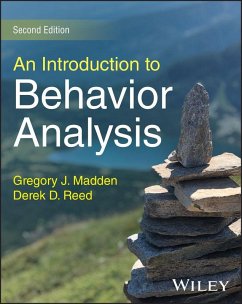- Gebundenes Buch
- Merkliste
- Auf die Merkliste
- Bewerten Bewerten
- Teilen
- Produkt teilen
- Produkterinnerung
- Produkterinnerung
The latest edition of the gold standard in introductory behavior analysis texts In the newly revised second edition of An Introduction to Behavior Analysis, a team of experienced researchers delivers an engaging and comprehensive introduction to the theoretical fundamentals and applications of behavior analysis. The authors focus on practical issues encountered by practicing behavior analysts, including Pavlovian and operant learning, reinforcement and punishment, motivation and stimulus control, and other key concepts in the field. The book clearly articulates and defends the philosophical…mehr
Andere Kunden interessierten sich auch für
![An Introduction to Critical Social Psychology An Introduction to Critical Social Psychology]() Alexa HepburnAn Introduction to Critical Social Psychology43,99 €
Alexa HepburnAn Introduction to Critical Social Psychology43,99 €![An Introduction to Psychology An Introduction to Psychology]() James Rowland AngellAn Introduction to Psychology56,90 €
James Rowland AngellAn Introduction to Psychology56,90 €![An Introduction to Artificial Psychology An Introduction to Artificial Psychology]() Hojjatollah FarahaniAn Introduction to Artificial Psychology151,99 €
Hojjatollah FarahaniAn Introduction to Artificial Psychology151,99 €![Introduction to Behavioral Science in Medicine Introduction to Behavioral Science in Medicine]() F. R. HineIntroduction to Behavioral Science in Medicine39,99 €
F. R. HineIntroduction to Behavioral Science in Medicine39,99 €![Data Analysis with Machine Learning for Psychologists Data Analysis with Machine Learning for Psychologists]() Chandril GhoshData Analysis with Machine Learning for Psychologists38,99 €
Chandril GhoshData Analysis with Machine Learning for Psychologists38,99 €![An Introduction to Artificial Psychology An Introduction to Artificial Psychology]() Hojjatollah FarahaniAn Introduction to Artificial Psychology151,99 €
Hojjatollah FarahaniAn Introduction to Artificial Psychology151,99 €![Introduction to Clinical Psychology Introduction to Clinical Psychology]() John HunsleyIntroduction to Clinical Psychology273,99 €
John HunsleyIntroduction to Clinical Psychology273,99 €-
-
-
The latest edition of the gold standard in introductory behavior analysis texts In the newly revised second edition of An Introduction to Behavior Analysis, a team of experienced researchers delivers an engaging and comprehensive introduction to the theoretical fundamentals and applications of behavior analysis. The authors focus on practical issues encountered by practicing behavior analysts, including Pavlovian and operant learning, reinforcement and punishment, motivation and stimulus control, and other key concepts in the field. The book clearly articulates and defends the philosophical assumptions and overarching goals of behavior analysis. It describes objective data collection, experimental methods, and data analysis in the context of modern psychology. You'll also find: * Core behavioral analysis principles explained in an accessible way that are appropriate for introductory audiences * Expert discussions of a variety of common behavior issues, including language, substance-use disorders, and psychological disorders * Up-to-date examinations of the latest empirical research and theory, along with identifications of areas that require further data and study * Complimentary access to a companion website containing PowerPoint slides and a test bank for each chapter Perfect for students undertaking their first course in behavior analysis or behavior modification, An Introduction to Behavior Analysis is also a must-read for trainees pursuing certification through the Behavior Analysis Certification Board and for students of the applied psychological sciences.
Produktdetails
- Produktdetails
- Verlag: John Wiley & Sons Inc
- 2. Auflage
- Seitenzahl: 496
- Erscheinungstermin: 12. März 2026
- Englisch
- ISBN-13: 9781394286706
- ISBN-10: 1394286708
- Artikelnr.: 75287956
- Herstellerkennzeichnung
- Libri GmbH
- Europaallee 1
- 36244 Bad Hersfeld
- gpsr@libri.de
- Verlag: John Wiley & Sons Inc
- 2. Auflage
- Seitenzahl: 496
- Erscheinungstermin: 12. März 2026
- Englisch
- ISBN-13: 9781394286706
- ISBN-10: 1394286708
- Artikelnr.: 75287956
- Herstellerkennzeichnung
- Libri GmbH
- Europaallee 1
- 36244 Bad Hersfeld
- gpsr@libri.de
Preface 1 An Introduction to Behavior Analysis 1 What Is Behavior? What Is Behavior Analysis? The Goals of Behavior Analysis The First Goal of Behavior Analysis The Second Goal of Behavior Analysis Demand More of Your Science Reading Quiz 1 The Assumptions of Behavior Analysis Assumption #1: Behavior is determined Mentalistic Explanations of Behavior I'm Not Buying It. I Determine My Own Behavior EXTRA BOX 1: Determinism Promotes Empathy and Compassion Assumption #2: The scientific method is a valid way to reveal the determinants of behavior Reading Quiz 2 Scientific Method Reading Quiz 3 What Are the Determinants of Behavior? Nature Nurture Behavioral Epigenetics The Activities of Behavior Analysts The Experimental Analysis of Behavior Applied Behavior Analysis EXTRA BOX 2: Dimensions of Applied Behavior Analysis Behavioral Service Delivery Organizational Behavior Management Certified Applied Animal Behaviorists Summary Reading Quiz 4 Reading Quiz Answers References 2 Behavioral Research and Measures Variables Correlation vs Causation Experiments Three Components of a Behavioral Experiment Reading Quiz 1 Choosing the Target Behavior Dimensions of Behavior Frequency Latency Duration Magnitude Measuring Behavior Indirect Observation Methods Self-Report Permanent-Product Recording Choosing the Right Observation Method (PART 1) Direct Observations Operational Definitions Social Validity of the Operational Definition Inter-Observer Agreement (IOA) What IOA is Not Reading Quiz 2 Conducting Direct Observations Event Recording Calculating IOA When Using Event Recording Interval Recording Partial-Interval Recording Whole-Interval Recording Calculating IOA When Partial-Or Whole-Interval Recording Duration Recording Calculating IOA When Using Duration Recording Calculating IOA When Using Permanent-Product Recording Choosing the Right Observation Method (PART 2) Reading Quiz 3 Summary Reading Quiz Answers References 3 Experimental Designs in Behavior Analysis Group Experimental Designs EXTRA BOX 1: The Price of Group Designs Single-Subject Experimental Designs Internal Validity of Single-Subject Experimental Designs Four Types of Single-Subject Experimental Designs Comparison (A-B) Design Reversal (A-B-A) Design EXTRA BOX 2: An ABA Reversal Design Experiment in the NBA Alternating-Treatments Design Multiple-Baseline Designs Defining Features of Single-Subject Designs Three Kinds of Replication Reading Quiz 1 Did Behavior Change? Two Patterns of Behavior Change What Makes a Change Convincing? Guidelines for Conducting the Visual Analysis What Is Responsible for the Change Reading Quiz 2 Supplementing the Visual Analysis with Inferential Statistics Summary Answers to Reading Quiz Questions References 4 Phylogenetic Behavior and Pavlovian Learning Phylogenetically Selected Behavior Reflex Learning - Habituation EXTRA BOX 1: Habituation and Happiness The "Nature and Nurture" Answer to the "Nature vs Nurture" Debate Elicited or Evoked? Reading Quiz 1 Pavlovian Learning The Discovery of Pavlovian Learning A Simple Pavlovian Conditioning Procedure Pavlovian Conditioning of Positive Emotions Pavlovian Conditioning of Negative Emotions 89 The Little Albert Experiment What Became of Little Albert? Fear Conditioning and Posttraumatic Stress Disorder Reading Quiz 2 What Is Learned During Pavlovian Conditioning? Pavlovian Learning Happens Automatically Four Principles of Effective Pavlovian Conditioning Applying these principles to Understanding PTSD Reading Quiz 3 Generalization Pavlovian Extinction-Based Therapy Graduated Exposure Therapy Spontaneous Recovery EXTRA BOX 2: Post-Traumatic Stress Disorder in Military Veterans Reading Quiz 4 Pavlovian Conditioning in Everyday Life Taste-Aversion Learning Advertising Summary Answers to Reading Quiz Questions References 5 Operant Learning I: Reinforcement Operant Behavior Reading Quiz 1 Response-Consequence Contingencies Learning Response-Consequence Contingencies Noncontingent Consequences Superstitious Behavior Reading Quiz 2 Changing Behavior with Contingent Consequences Extra Box 1: Noncontingent Consequences in North Korea Reinforcers, Reinforcement, and Rewards Reading Quiz 3 The Discovery of Reinforcement Is it a Reinforcer? From Puzzle Boxes to Skinner Boxes Reading Quiz 4 Reinforcement in Daily Life Response Variability: Exploring & Exploiting Extra Box 2: Add Some Variability to Your Life The Generic Nature of Operant Behavior Not Every Consequence Functions as a Reinforcer Reading Quiz 5 Reinforcement in Social Media and Video Games Games for Good Summary Reading Quiz & Table 5.2 Answers References 6 Operant Learning II: Positive and Negative Reinforcement Positive Reinforcement Positive Reinforcement in the Lab Negative Reinforcement Negative Reinforcement - Escape (SRE-) Negative Reinforcement - Escape (SRE-) in the Lab Negative Reinforcement - Avoidance (SRA
) Negative Reinforcement - Avoidance (SRA
) in the Lab Extra Box 1: What Is the Consequence in SRA
? Distinguishing Between SRE- and SRA
Reading Quiz 1 Positive or Negative Reinforcement: Is There Really a Difference? Reason 1: Heuristics Reason 2: Loss Aversion Using Reinforcement to Positively Influence Behavior Reinforcement in the Workplace Three Objections to Reinforcement Objection 1: Intrinsic Motivation Objection 2: Performance-Inhibiting Properties of Reinforcement Objection 3: The Alignment Problem Reading Quiz 2 Theories of Reinforcement The Response Strengthening Theory of Reinforcement The Information Theory of Reinforcement Evaluating the Theories Reading Quiz 3 Summary Reading Quiz Answers References 7 Operant Extinction & Differential Reinforcement Operant Extinction Following Positive Reinforcement Operant Extinction Following Negative Reinforcement How Quickly Will Operant Extinction Work? Rate of Reinforcement Prior to Extinction Motivation Spontaneous Recovery of Operant Behavior Reading Quiz 1 Extra Box 1: How Extinction Informs Theories of Reinforcement Other Predictable Effects of Extinction Extinction-Induced Emotional Behavior Extinction Burst Extinction-Induced Variability Extinction-Induced Resurgence We Tried It at Home Reading Quiz 2 Using Extinction to Positively Influence Behavior Functional Analysis of Behavior Functional Analysis of Self-Injurious Behavior EXTRA BOX 2: Functional Analysis of Charitable Giving Differential Reinforcement Therapeutic Use of Differential Reinforcement Differential Reinforcement Without Extinction How to Effectively Use Differential Reinforcement Differentially Reinforcing Topography Differentially Reinforcing Rate of Operant Behavior Reading Quiz 3 Summary Reading Quiz Answers References 8 Unconditioned Reinforcers, Conditioned Reinforcers, and Shaping Unconditioned Reinforcers Conditioned Reinforcers Pavlovian Learning and Conditioned Reinforcers Verbal Learning and Conditioned Reinforcers The Token Economy Reading Quiz 1 Arranging Effective Conditioned Reinforcers Principle 1: Use an Effective Backup Reinforcer Principle 2: Use a Salient Conditioned Reinforcer Principle 3: The Conditioned Reinforcer Should Signal a Significant Reduction in the Delay to the Backup Reinforcer Principle 4: The Conditioned Reinforcer Must be the Only Stimulus Signaling the Delay Reduction to the Backup Reinforcer Extra Box 1: Conditioned Reinforcers in Zoos Clicker Training with Humans Reading Quiz 2 Shaping Extra Box 2: Shaping Animal Behavior on the Farm Shaping Human Behavior Shaping and Flow Principles of Effective Shaping Automating Shaping: Percentile Schedules of Reinforcement Reading Quiz 3 Summary Answers to Reading Quizes References 226 9 Motivation, Reinforcer Efficacy, and Habit Formation Everyday Concepts of Motivation From Motivation to Motivating Operations Two Kinds of Motivating Operations Examples of EOs Examples of AOs Motivating Operations Require Response-Reinforcer Contingency Learning The Therapeutic Utility of Motivating Operations Extra Box 1: The Cost of Mentalistic Reasoning Reading Quiz 1 Identifying Effective Reinforcers: The "Liking" Strategy Reinforcer Surveys Stimulus Preference Assessments Extra Box 2: Avoiding Circularity - Response Disequilibrirum Theory Reading Quiz 2 Measuring Reinforcer Efficacy Dimensions of Effective Reinforcers Contingency Reinforcer Size Reinforcer Quality Reinforcer Immediacy EXTRA BOX 3: Reinforcing Altruism Habit Formation Habits - What Are They and How Are They Formed Our Everyday Habits Replacing Bad Habits with Good Ones Reading Quiz 3 Chapter Summary Answers to Reading Quizzes References 10 Punishment Punishers and Punishment Unconditioned and Conditioned Punishment Positive and Negative Punishment - Both Decrease Behavior 261 Positive Punishment Negative Punishment Reading Quiz 1 When Should We Punish? A Deeper Dive on Punishment Critiques EXTRA BOX 1. The Ethics of Electric Shock Punishment in Applied Behavior Analysis Punishment is the Norm-Using it Effectively is Humane Six Characteristics of Effective Punishment 1. Focus on Reinforcement First 2. Combine Punishment with Extinction and/or Differential Reinforcement 3. Deliver Punishers Immediately 4. Deliver Punishment Contingently 5. Punish Every Time 6. Use the Least-Intense Punisher That Works Reading Quiz 2 Two Practical Negative-Punishment Procedures Time-out from Positive Reinforcement Response-Cost Punishment The Watchful Eye of the Punisher The Role of Reinforcement in the Act of Punishing Reading Quiz 3 Chapter Summary Answers to Reading Quiz Questions References 11 Complex Contingencies of Reinforcement Schedules of Reinforcement Ratio Schedules of Reinforcement Fixed-Ratio Schedules Variable-Ratio Schedules The Behavioral Economics of Ratio Schedules The Underappreciated VR Schedule Reading Quiz 1 Interval Schedules of Reinforcement Fixed-Interval Schedules Variable-Interval Schedules Putting it All Together Reading Quiz 2 Why Study Schedules of Reinforcement? Extra Box 1: Contingency Management of Substance-Use Disorders Schedule Thinning Scheduling Reinforcers to Enhance Human Performance and Wellbeing Increasing Spontaneity with Lag Schedules of Reinforcement Reading Quiz 3 Summary Answers to Reading Quiz Questions and Questions Posed in Tables 11.1-11.4 References 12 Antecedent Stimulus Control Phylogenetic and Pavlovian Stimulus Control Discriminated Operant Behavior The Discriminative Stimulus (SD) The S
The SDp The Three-term Contingency Reading Quiz 1 Discriminative Stimuli and Establishing Operations Discriminative Stimuli and Conditioned Reinforcement Discrimination Training Effective Methods of Discrimination Training EXTRA BOX 1: Direct Instruction of Reading Skills Using Discrimination Training to Positively Influence Behavior Generalization Using Discrimination Training to Improve Stimulus Control Promoting Generalization and Maintenance Tactic 1: Teach Behaviors That Will Contact Natural Contingencies of Reinforcement Tactic 2: Train Diversely Tactic 3: Arrange Antecedent Stimuli That Will Cue Generalization Reading Quiz 2 Stimulus-Response Chains Teaching Stimulus-Response Chains Prompting and Fading Extra Box 2: Stimulus Control and Consciousness 343 Reading Quiz 3 Chapter Summary Answers to Reading Quizzes References 13 Choice What Is Choice? Four Variables Affecting Choice Reinforcement vs. No Consequence Reinforcer Size/Quality Effort Reinforcer Delay Summary Reading Quiz 1 The Rich Uncle Joe Experiment Choosing between Uncertain Outcomes Herrnstein's Matching Equation Adding Uncertainty Replications Across Species Reading Quiz 2 Extra Box 1: The Matching Law, Terrorism, and White Nationalism Substitutes Extra Box 2: What Substitutes for Drug Reinforcers? Using the Matching Law to Positively Influence Behavior Increasing Socially Desirable Behavior Decreasing Undesirable Behavior The Matching Law and Attention Summary Reading Quiz 3 Impulsive and Self-Control Choices Predicting Impulsive Choice Predicting Preference Reversals Reducing Impulsive Choice Commitment Strategies Delay-Exposure Training 380 Reading Quiz 4 Summary Reading Quiz & Table 3 Answers References 14 Verbal Behavior, Rule-Following, and Clinical Behavior Analysis Behavioral Approaches to Language Skinner's Functional Analysis of Speaker Behavior Echoic Mand Tact Intraverbal Training Verbal Operants Reading Quiz 1 The Behavior of the Listener Expanding the Verbal Repertoire Verbal Behavior and Emotions Reading Quiz 2 Rules and Rule-Governed Behavior Why Follow the Rules? Pliance Tracking Persistently Following Incorrect Rules Are We Hopelessly Compliant? The Dark Side of Tracking Reading Quiz 3 Breaking the Rules in Clinical Psychology Extra Box 1: If Thoughts Are Important, Prepare to Suffer The "Acceptance" in Acceptance and Commitment Therapy The "Commitment" in Acceptance and Commitment Therapy EXTRA BOX 2: Personal Values Exercise Does ACT Work? Reading Quiz 4 Summary Supplemental Readings Answers to Reading Quizzes References Appendix Glossary
) Negative Reinforcement - Avoidance (SRA
) in the Lab Extra Box 1: What Is the Consequence in SRA
? Distinguishing Between SRE- and SRA
Reading Quiz 1 Positive or Negative Reinforcement: Is There Really a Difference? Reason 1: Heuristics Reason 2: Loss Aversion Using Reinforcement to Positively Influence Behavior Reinforcement in the Workplace Three Objections to Reinforcement Objection 1: Intrinsic Motivation Objection 2: Performance-Inhibiting Properties of Reinforcement Objection 3: The Alignment Problem Reading Quiz 2 Theories of Reinforcement The Response Strengthening Theory of Reinforcement The Information Theory of Reinforcement Evaluating the Theories Reading Quiz 3 Summary Reading Quiz Answers References 7 Operant Extinction & Differential Reinforcement Operant Extinction Following Positive Reinforcement Operant Extinction Following Negative Reinforcement How Quickly Will Operant Extinction Work? Rate of Reinforcement Prior to Extinction Motivation Spontaneous Recovery of Operant Behavior Reading Quiz 1 Extra Box 1: How Extinction Informs Theories of Reinforcement Other Predictable Effects of Extinction Extinction-Induced Emotional Behavior Extinction Burst Extinction-Induced Variability Extinction-Induced Resurgence We Tried It at Home Reading Quiz 2 Using Extinction to Positively Influence Behavior Functional Analysis of Behavior Functional Analysis of Self-Injurious Behavior EXTRA BOX 2: Functional Analysis of Charitable Giving Differential Reinforcement Therapeutic Use of Differential Reinforcement Differential Reinforcement Without Extinction How to Effectively Use Differential Reinforcement Differentially Reinforcing Topography Differentially Reinforcing Rate of Operant Behavior Reading Quiz 3 Summary Reading Quiz Answers References 8 Unconditioned Reinforcers, Conditioned Reinforcers, and Shaping Unconditioned Reinforcers Conditioned Reinforcers Pavlovian Learning and Conditioned Reinforcers Verbal Learning and Conditioned Reinforcers The Token Economy Reading Quiz 1 Arranging Effective Conditioned Reinforcers Principle 1: Use an Effective Backup Reinforcer Principle 2: Use a Salient Conditioned Reinforcer Principle 3: The Conditioned Reinforcer Should Signal a Significant Reduction in the Delay to the Backup Reinforcer Principle 4: The Conditioned Reinforcer Must be the Only Stimulus Signaling the Delay Reduction to the Backup Reinforcer Extra Box 1: Conditioned Reinforcers in Zoos Clicker Training with Humans Reading Quiz 2 Shaping Extra Box 2: Shaping Animal Behavior on the Farm Shaping Human Behavior Shaping and Flow Principles of Effective Shaping Automating Shaping: Percentile Schedules of Reinforcement Reading Quiz 3 Summary Answers to Reading Quizes References 226 9 Motivation, Reinforcer Efficacy, and Habit Formation Everyday Concepts of Motivation From Motivation to Motivating Operations Two Kinds of Motivating Operations Examples of EOs Examples of AOs Motivating Operations Require Response-Reinforcer Contingency Learning The Therapeutic Utility of Motivating Operations Extra Box 1: The Cost of Mentalistic Reasoning Reading Quiz 1 Identifying Effective Reinforcers: The "Liking" Strategy Reinforcer Surveys Stimulus Preference Assessments Extra Box 2: Avoiding Circularity - Response Disequilibrirum Theory Reading Quiz 2 Measuring Reinforcer Efficacy Dimensions of Effective Reinforcers Contingency Reinforcer Size Reinforcer Quality Reinforcer Immediacy EXTRA BOX 3: Reinforcing Altruism Habit Formation Habits - What Are They and How Are They Formed Our Everyday Habits Replacing Bad Habits with Good Ones Reading Quiz 3 Chapter Summary Answers to Reading Quizzes References 10 Punishment Punishers and Punishment Unconditioned and Conditioned Punishment Positive and Negative Punishment - Both Decrease Behavior 261 Positive Punishment Negative Punishment Reading Quiz 1 When Should We Punish? A Deeper Dive on Punishment Critiques EXTRA BOX 1. The Ethics of Electric Shock Punishment in Applied Behavior Analysis Punishment is the Norm-Using it Effectively is Humane Six Characteristics of Effective Punishment 1. Focus on Reinforcement First 2. Combine Punishment with Extinction and/or Differential Reinforcement 3. Deliver Punishers Immediately 4. Deliver Punishment Contingently 5. Punish Every Time 6. Use the Least-Intense Punisher That Works Reading Quiz 2 Two Practical Negative-Punishment Procedures Time-out from Positive Reinforcement Response-Cost Punishment The Watchful Eye of the Punisher The Role of Reinforcement in the Act of Punishing Reading Quiz 3 Chapter Summary Answers to Reading Quiz Questions References 11 Complex Contingencies of Reinforcement Schedules of Reinforcement Ratio Schedules of Reinforcement Fixed-Ratio Schedules Variable-Ratio Schedules The Behavioral Economics of Ratio Schedules The Underappreciated VR Schedule Reading Quiz 1 Interval Schedules of Reinforcement Fixed-Interval Schedules Variable-Interval Schedules Putting it All Together Reading Quiz 2 Why Study Schedules of Reinforcement? Extra Box 1: Contingency Management of Substance-Use Disorders Schedule Thinning Scheduling Reinforcers to Enhance Human Performance and Wellbeing Increasing Spontaneity with Lag Schedules of Reinforcement Reading Quiz 3 Summary Answers to Reading Quiz Questions and Questions Posed in Tables 11.1-11.4 References 12 Antecedent Stimulus Control Phylogenetic and Pavlovian Stimulus Control Discriminated Operant Behavior The Discriminative Stimulus (SD) The S
The SDp The Three-term Contingency Reading Quiz 1 Discriminative Stimuli and Establishing Operations Discriminative Stimuli and Conditioned Reinforcement Discrimination Training Effective Methods of Discrimination Training EXTRA BOX 1: Direct Instruction of Reading Skills Using Discrimination Training to Positively Influence Behavior Generalization Using Discrimination Training to Improve Stimulus Control Promoting Generalization and Maintenance Tactic 1: Teach Behaviors That Will Contact Natural Contingencies of Reinforcement Tactic 2: Train Diversely Tactic 3: Arrange Antecedent Stimuli That Will Cue Generalization Reading Quiz 2 Stimulus-Response Chains Teaching Stimulus-Response Chains Prompting and Fading Extra Box 2: Stimulus Control and Consciousness 343 Reading Quiz 3 Chapter Summary Answers to Reading Quizzes References 13 Choice What Is Choice? Four Variables Affecting Choice Reinforcement vs. No Consequence Reinforcer Size/Quality Effort Reinforcer Delay Summary Reading Quiz 1 The Rich Uncle Joe Experiment Choosing between Uncertain Outcomes Herrnstein's Matching Equation Adding Uncertainty Replications Across Species Reading Quiz 2 Extra Box 1: The Matching Law, Terrorism, and White Nationalism Substitutes Extra Box 2: What Substitutes for Drug Reinforcers? Using the Matching Law to Positively Influence Behavior Increasing Socially Desirable Behavior Decreasing Undesirable Behavior The Matching Law and Attention Summary Reading Quiz 3 Impulsive and Self-Control Choices Predicting Impulsive Choice Predicting Preference Reversals Reducing Impulsive Choice Commitment Strategies Delay-Exposure Training 380 Reading Quiz 4 Summary Reading Quiz & Table 3 Answers References 14 Verbal Behavior, Rule-Following, and Clinical Behavior Analysis Behavioral Approaches to Language Skinner's Functional Analysis of Speaker Behavior Echoic Mand Tact Intraverbal Training Verbal Operants Reading Quiz 1 The Behavior of the Listener Expanding the Verbal Repertoire Verbal Behavior and Emotions Reading Quiz 2 Rules and Rule-Governed Behavior Why Follow the Rules? Pliance Tracking Persistently Following Incorrect Rules Are We Hopelessly Compliant? The Dark Side of Tracking Reading Quiz 3 Breaking the Rules in Clinical Psychology Extra Box 1: If Thoughts Are Important, Prepare to Suffer The "Acceptance" in Acceptance and Commitment Therapy The "Commitment" in Acceptance and Commitment Therapy EXTRA BOX 2: Personal Values Exercise Does ACT Work? Reading Quiz 4 Summary Supplemental Readings Answers to Reading Quizzes References Appendix Glossary
Preface 1 An Introduction to Behavior Analysis 1 What Is Behavior? What Is Behavior Analysis? The Goals of Behavior Analysis The First Goal of Behavior Analysis The Second Goal of Behavior Analysis Demand More of Your Science Reading Quiz 1 The Assumptions of Behavior Analysis Assumption #1: Behavior is determined Mentalistic Explanations of Behavior I'm Not Buying It. I Determine My Own Behavior EXTRA BOX 1: Determinism Promotes Empathy and Compassion Assumption #2: The scientific method is a valid way to reveal the determinants of behavior Reading Quiz 2 Scientific Method Reading Quiz 3 What Are the Determinants of Behavior? Nature Nurture Behavioral Epigenetics The Activities of Behavior Analysts The Experimental Analysis of Behavior Applied Behavior Analysis EXTRA BOX 2: Dimensions of Applied Behavior Analysis Behavioral Service Delivery Organizational Behavior Management Certified Applied Animal Behaviorists Summary Reading Quiz 4 Reading Quiz Answers References 2 Behavioral Research and Measures Variables Correlation vs Causation Experiments Three Components of a Behavioral Experiment Reading Quiz 1 Choosing the Target Behavior Dimensions of Behavior Frequency Latency Duration Magnitude Measuring Behavior Indirect Observation Methods Self-Report Permanent-Product Recording Choosing the Right Observation Method (PART 1) Direct Observations Operational Definitions Social Validity of the Operational Definition Inter-Observer Agreement (IOA) What IOA is Not Reading Quiz 2 Conducting Direct Observations Event Recording Calculating IOA When Using Event Recording Interval Recording Partial-Interval Recording Whole-Interval Recording Calculating IOA When Partial-Or Whole-Interval Recording Duration Recording Calculating IOA When Using Duration Recording Calculating IOA When Using Permanent-Product Recording Choosing the Right Observation Method (PART 2) Reading Quiz 3 Summary Reading Quiz Answers References 3 Experimental Designs in Behavior Analysis Group Experimental Designs EXTRA BOX 1: The Price of Group Designs Single-Subject Experimental Designs Internal Validity of Single-Subject Experimental Designs Four Types of Single-Subject Experimental Designs Comparison (A-B) Design Reversal (A-B-A) Design EXTRA BOX 2: An ABA Reversal Design Experiment in the NBA Alternating-Treatments Design Multiple-Baseline Designs Defining Features of Single-Subject Designs Three Kinds of Replication Reading Quiz 1 Did Behavior Change? Two Patterns of Behavior Change What Makes a Change Convincing? Guidelines for Conducting the Visual Analysis What Is Responsible for the Change Reading Quiz 2 Supplementing the Visual Analysis with Inferential Statistics Summary Answers to Reading Quiz Questions References 4 Phylogenetic Behavior and Pavlovian Learning Phylogenetically Selected Behavior Reflex Learning - Habituation EXTRA BOX 1: Habituation and Happiness The "Nature and Nurture" Answer to the "Nature vs Nurture" Debate Elicited or Evoked? Reading Quiz 1 Pavlovian Learning The Discovery of Pavlovian Learning A Simple Pavlovian Conditioning Procedure Pavlovian Conditioning of Positive Emotions Pavlovian Conditioning of Negative Emotions 89 The Little Albert Experiment What Became of Little Albert? Fear Conditioning and Posttraumatic Stress Disorder Reading Quiz 2 What Is Learned During Pavlovian Conditioning? Pavlovian Learning Happens Automatically Four Principles of Effective Pavlovian Conditioning Applying these principles to Understanding PTSD Reading Quiz 3 Generalization Pavlovian Extinction-Based Therapy Graduated Exposure Therapy Spontaneous Recovery EXTRA BOX 2: Post-Traumatic Stress Disorder in Military Veterans Reading Quiz 4 Pavlovian Conditioning in Everyday Life Taste-Aversion Learning Advertising Summary Answers to Reading Quiz Questions References 5 Operant Learning I: Reinforcement Operant Behavior Reading Quiz 1 Response-Consequence Contingencies Learning Response-Consequence Contingencies Noncontingent Consequences Superstitious Behavior Reading Quiz 2 Changing Behavior with Contingent Consequences Extra Box 1: Noncontingent Consequences in North Korea Reinforcers, Reinforcement, and Rewards Reading Quiz 3 The Discovery of Reinforcement Is it a Reinforcer? From Puzzle Boxes to Skinner Boxes Reading Quiz 4 Reinforcement in Daily Life Response Variability: Exploring & Exploiting Extra Box 2: Add Some Variability to Your Life The Generic Nature of Operant Behavior Not Every Consequence Functions as a Reinforcer Reading Quiz 5 Reinforcement in Social Media and Video Games Games for Good Summary Reading Quiz & Table 5.2 Answers References 6 Operant Learning II: Positive and Negative Reinforcement Positive Reinforcement Positive Reinforcement in the Lab Negative Reinforcement Negative Reinforcement - Escape (SRE-) Negative Reinforcement - Escape (SRE-) in the Lab Negative Reinforcement - Avoidance (SRA
) Negative Reinforcement - Avoidance (SRA
) in the Lab Extra Box 1: What Is the Consequence in SRA
? Distinguishing Between SRE- and SRA
Reading Quiz 1 Positive or Negative Reinforcement: Is There Really a Difference? Reason 1: Heuristics Reason 2: Loss Aversion Using Reinforcement to Positively Influence Behavior Reinforcement in the Workplace Three Objections to Reinforcement Objection 1: Intrinsic Motivation Objection 2: Performance-Inhibiting Properties of Reinforcement Objection 3: The Alignment Problem Reading Quiz 2 Theories of Reinforcement The Response Strengthening Theory of Reinforcement The Information Theory of Reinforcement Evaluating the Theories Reading Quiz 3 Summary Reading Quiz Answers References 7 Operant Extinction & Differential Reinforcement Operant Extinction Following Positive Reinforcement Operant Extinction Following Negative Reinforcement How Quickly Will Operant Extinction Work? Rate of Reinforcement Prior to Extinction Motivation Spontaneous Recovery of Operant Behavior Reading Quiz 1 Extra Box 1: How Extinction Informs Theories of Reinforcement Other Predictable Effects of Extinction Extinction-Induced Emotional Behavior Extinction Burst Extinction-Induced Variability Extinction-Induced Resurgence We Tried It at Home Reading Quiz 2 Using Extinction to Positively Influence Behavior Functional Analysis of Behavior Functional Analysis of Self-Injurious Behavior EXTRA BOX 2: Functional Analysis of Charitable Giving Differential Reinforcement Therapeutic Use of Differential Reinforcement Differential Reinforcement Without Extinction How to Effectively Use Differential Reinforcement Differentially Reinforcing Topography Differentially Reinforcing Rate of Operant Behavior Reading Quiz 3 Summary Reading Quiz Answers References 8 Unconditioned Reinforcers, Conditioned Reinforcers, and Shaping Unconditioned Reinforcers Conditioned Reinforcers Pavlovian Learning and Conditioned Reinforcers Verbal Learning and Conditioned Reinforcers The Token Economy Reading Quiz 1 Arranging Effective Conditioned Reinforcers Principle 1: Use an Effective Backup Reinforcer Principle 2: Use a Salient Conditioned Reinforcer Principle 3: The Conditioned Reinforcer Should Signal a Significant Reduction in the Delay to the Backup Reinforcer Principle 4: The Conditioned Reinforcer Must be the Only Stimulus Signaling the Delay Reduction to the Backup Reinforcer Extra Box 1: Conditioned Reinforcers in Zoos Clicker Training with Humans Reading Quiz 2 Shaping Extra Box 2: Shaping Animal Behavior on the Farm Shaping Human Behavior Shaping and Flow Principles of Effective Shaping Automating Shaping: Percentile Schedules of Reinforcement Reading Quiz 3 Summary Answers to Reading Quizes References 226 9 Motivation, Reinforcer Efficacy, and Habit Formation Everyday Concepts of Motivation From Motivation to Motivating Operations Two Kinds of Motivating Operations Examples of EOs Examples of AOs Motivating Operations Require Response-Reinforcer Contingency Learning The Therapeutic Utility of Motivating Operations Extra Box 1: The Cost of Mentalistic Reasoning Reading Quiz 1 Identifying Effective Reinforcers: The "Liking" Strategy Reinforcer Surveys Stimulus Preference Assessments Extra Box 2: Avoiding Circularity - Response Disequilibrirum Theory Reading Quiz 2 Measuring Reinforcer Efficacy Dimensions of Effective Reinforcers Contingency Reinforcer Size Reinforcer Quality Reinforcer Immediacy EXTRA BOX 3: Reinforcing Altruism Habit Formation Habits - What Are They and How Are They Formed Our Everyday Habits Replacing Bad Habits with Good Ones Reading Quiz 3 Chapter Summary Answers to Reading Quizzes References 10 Punishment Punishers and Punishment Unconditioned and Conditioned Punishment Positive and Negative Punishment - Both Decrease Behavior 261 Positive Punishment Negative Punishment Reading Quiz 1 When Should We Punish? A Deeper Dive on Punishment Critiques EXTRA BOX 1. The Ethics of Electric Shock Punishment in Applied Behavior Analysis Punishment is the Norm-Using it Effectively is Humane Six Characteristics of Effective Punishment 1. Focus on Reinforcement First 2. Combine Punishment with Extinction and/or Differential Reinforcement 3. Deliver Punishers Immediately 4. Deliver Punishment Contingently 5. Punish Every Time 6. Use the Least-Intense Punisher That Works Reading Quiz 2 Two Practical Negative-Punishment Procedures Time-out from Positive Reinforcement Response-Cost Punishment The Watchful Eye of the Punisher The Role of Reinforcement in the Act of Punishing Reading Quiz 3 Chapter Summary Answers to Reading Quiz Questions References 11 Complex Contingencies of Reinforcement Schedules of Reinforcement Ratio Schedules of Reinforcement Fixed-Ratio Schedules Variable-Ratio Schedules The Behavioral Economics of Ratio Schedules The Underappreciated VR Schedule Reading Quiz 1 Interval Schedules of Reinforcement Fixed-Interval Schedules Variable-Interval Schedules Putting it All Together Reading Quiz 2 Why Study Schedules of Reinforcement? Extra Box 1: Contingency Management of Substance-Use Disorders Schedule Thinning Scheduling Reinforcers to Enhance Human Performance and Wellbeing Increasing Spontaneity with Lag Schedules of Reinforcement Reading Quiz 3 Summary Answers to Reading Quiz Questions and Questions Posed in Tables 11.1-11.4 References 12 Antecedent Stimulus Control Phylogenetic and Pavlovian Stimulus Control Discriminated Operant Behavior The Discriminative Stimulus (SD) The S
The SDp The Three-term Contingency Reading Quiz 1 Discriminative Stimuli and Establishing Operations Discriminative Stimuli and Conditioned Reinforcement Discrimination Training Effective Methods of Discrimination Training EXTRA BOX 1: Direct Instruction of Reading Skills Using Discrimination Training to Positively Influence Behavior Generalization Using Discrimination Training to Improve Stimulus Control Promoting Generalization and Maintenance Tactic 1: Teach Behaviors That Will Contact Natural Contingencies of Reinforcement Tactic 2: Train Diversely Tactic 3: Arrange Antecedent Stimuli That Will Cue Generalization Reading Quiz 2 Stimulus-Response Chains Teaching Stimulus-Response Chains Prompting and Fading Extra Box 2: Stimulus Control and Consciousness 343 Reading Quiz 3 Chapter Summary Answers to Reading Quizzes References 13 Choice What Is Choice? Four Variables Affecting Choice Reinforcement vs. No Consequence Reinforcer Size/Quality Effort Reinforcer Delay Summary Reading Quiz 1 The Rich Uncle Joe Experiment Choosing between Uncertain Outcomes Herrnstein's Matching Equation Adding Uncertainty Replications Across Species Reading Quiz 2 Extra Box 1: The Matching Law, Terrorism, and White Nationalism Substitutes Extra Box 2: What Substitutes for Drug Reinforcers? Using the Matching Law to Positively Influence Behavior Increasing Socially Desirable Behavior Decreasing Undesirable Behavior The Matching Law and Attention Summary Reading Quiz 3 Impulsive and Self-Control Choices Predicting Impulsive Choice Predicting Preference Reversals Reducing Impulsive Choice Commitment Strategies Delay-Exposure Training 380 Reading Quiz 4 Summary Reading Quiz & Table 3 Answers References 14 Verbal Behavior, Rule-Following, and Clinical Behavior Analysis Behavioral Approaches to Language Skinner's Functional Analysis of Speaker Behavior Echoic Mand Tact Intraverbal Training Verbal Operants Reading Quiz 1 The Behavior of the Listener Expanding the Verbal Repertoire Verbal Behavior and Emotions Reading Quiz 2 Rules and Rule-Governed Behavior Why Follow the Rules? Pliance Tracking Persistently Following Incorrect Rules Are We Hopelessly Compliant? The Dark Side of Tracking Reading Quiz 3 Breaking the Rules in Clinical Psychology Extra Box 1: If Thoughts Are Important, Prepare to Suffer The "Acceptance" in Acceptance and Commitment Therapy The "Commitment" in Acceptance and Commitment Therapy EXTRA BOX 2: Personal Values Exercise Does ACT Work? Reading Quiz 4 Summary Supplemental Readings Answers to Reading Quizzes References Appendix Glossary
) Negative Reinforcement - Avoidance (SRA
) in the Lab Extra Box 1: What Is the Consequence in SRA
? Distinguishing Between SRE- and SRA
Reading Quiz 1 Positive or Negative Reinforcement: Is There Really a Difference? Reason 1: Heuristics Reason 2: Loss Aversion Using Reinforcement to Positively Influence Behavior Reinforcement in the Workplace Three Objections to Reinforcement Objection 1: Intrinsic Motivation Objection 2: Performance-Inhibiting Properties of Reinforcement Objection 3: The Alignment Problem Reading Quiz 2 Theories of Reinforcement The Response Strengthening Theory of Reinforcement The Information Theory of Reinforcement Evaluating the Theories Reading Quiz 3 Summary Reading Quiz Answers References 7 Operant Extinction & Differential Reinforcement Operant Extinction Following Positive Reinforcement Operant Extinction Following Negative Reinforcement How Quickly Will Operant Extinction Work? Rate of Reinforcement Prior to Extinction Motivation Spontaneous Recovery of Operant Behavior Reading Quiz 1 Extra Box 1: How Extinction Informs Theories of Reinforcement Other Predictable Effects of Extinction Extinction-Induced Emotional Behavior Extinction Burst Extinction-Induced Variability Extinction-Induced Resurgence We Tried It at Home Reading Quiz 2 Using Extinction to Positively Influence Behavior Functional Analysis of Behavior Functional Analysis of Self-Injurious Behavior EXTRA BOX 2: Functional Analysis of Charitable Giving Differential Reinforcement Therapeutic Use of Differential Reinforcement Differential Reinforcement Without Extinction How to Effectively Use Differential Reinforcement Differentially Reinforcing Topography Differentially Reinforcing Rate of Operant Behavior Reading Quiz 3 Summary Reading Quiz Answers References 8 Unconditioned Reinforcers, Conditioned Reinforcers, and Shaping Unconditioned Reinforcers Conditioned Reinforcers Pavlovian Learning and Conditioned Reinforcers Verbal Learning and Conditioned Reinforcers The Token Economy Reading Quiz 1 Arranging Effective Conditioned Reinforcers Principle 1: Use an Effective Backup Reinforcer Principle 2: Use a Salient Conditioned Reinforcer Principle 3: The Conditioned Reinforcer Should Signal a Significant Reduction in the Delay to the Backup Reinforcer Principle 4: The Conditioned Reinforcer Must be the Only Stimulus Signaling the Delay Reduction to the Backup Reinforcer Extra Box 1: Conditioned Reinforcers in Zoos Clicker Training with Humans Reading Quiz 2 Shaping Extra Box 2: Shaping Animal Behavior on the Farm Shaping Human Behavior Shaping and Flow Principles of Effective Shaping Automating Shaping: Percentile Schedules of Reinforcement Reading Quiz 3 Summary Answers to Reading Quizes References 226 9 Motivation, Reinforcer Efficacy, and Habit Formation Everyday Concepts of Motivation From Motivation to Motivating Operations Two Kinds of Motivating Operations Examples of EOs Examples of AOs Motivating Operations Require Response-Reinforcer Contingency Learning The Therapeutic Utility of Motivating Operations Extra Box 1: The Cost of Mentalistic Reasoning Reading Quiz 1 Identifying Effective Reinforcers: The "Liking" Strategy Reinforcer Surveys Stimulus Preference Assessments Extra Box 2: Avoiding Circularity - Response Disequilibrirum Theory Reading Quiz 2 Measuring Reinforcer Efficacy Dimensions of Effective Reinforcers Contingency Reinforcer Size Reinforcer Quality Reinforcer Immediacy EXTRA BOX 3: Reinforcing Altruism Habit Formation Habits - What Are They and How Are They Formed Our Everyday Habits Replacing Bad Habits with Good Ones Reading Quiz 3 Chapter Summary Answers to Reading Quizzes References 10 Punishment Punishers and Punishment Unconditioned and Conditioned Punishment Positive and Negative Punishment - Both Decrease Behavior 261 Positive Punishment Negative Punishment Reading Quiz 1 When Should We Punish? A Deeper Dive on Punishment Critiques EXTRA BOX 1. The Ethics of Electric Shock Punishment in Applied Behavior Analysis Punishment is the Norm-Using it Effectively is Humane Six Characteristics of Effective Punishment 1. Focus on Reinforcement First 2. Combine Punishment with Extinction and/or Differential Reinforcement 3. Deliver Punishers Immediately 4. Deliver Punishment Contingently 5. Punish Every Time 6. Use the Least-Intense Punisher That Works Reading Quiz 2 Two Practical Negative-Punishment Procedures Time-out from Positive Reinforcement Response-Cost Punishment The Watchful Eye of the Punisher The Role of Reinforcement in the Act of Punishing Reading Quiz 3 Chapter Summary Answers to Reading Quiz Questions References 11 Complex Contingencies of Reinforcement Schedules of Reinforcement Ratio Schedules of Reinforcement Fixed-Ratio Schedules Variable-Ratio Schedules The Behavioral Economics of Ratio Schedules The Underappreciated VR Schedule Reading Quiz 1 Interval Schedules of Reinforcement Fixed-Interval Schedules Variable-Interval Schedules Putting it All Together Reading Quiz 2 Why Study Schedules of Reinforcement? Extra Box 1: Contingency Management of Substance-Use Disorders Schedule Thinning Scheduling Reinforcers to Enhance Human Performance and Wellbeing Increasing Spontaneity with Lag Schedules of Reinforcement Reading Quiz 3 Summary Answers to Reading Quiz Questions and Questions Posed in Tables 11.1-11.4 References 12 Antecedent Stimulus Control Phylogenetic and Pavlovian Stimulus Control Discriminated Operant Behavior The Discriminative Stimulus (SD) The S
The SDp The Three-term Contingency Reading Quiz 1 Discriminative Stimuli and Establishing Operations Discriminative Stimuli and Conditioned Reinforcement Discrimination Training Effective Methods of Discrimination Training EXTRA BOX 1: Direct Instruction of Reading Skills Using Discrimination Training to Positively Influence Behavior Generalization Using Discrimination Training to Improve Stimulus Control Promoting Generalization and Maintenance Tactic 1: Teach Behaviors That Will Contact Natural Contingencies of Reinforcement Tactic 2: Train Diversely Tactic 3: Arrange Antecedent Stimuli That Will Cue Generalization Reading Quiz 2 Stimulus-Response Chains Teaching Stimulus-Response Chains Prompting and Fading Extra Box 2: Stimulus Control and Consciousness 343 Reading Quiz 3 Chapter Summary Answers to Reading Quizzes References 13 Choice What Is Choice? Four Variables Affecting Choice Reinforcement vs. No Consequence Reinforcer Size/Quality Effort Reinforcer Delay Summary Reading Quiz 1 The Rich Uncle Joe Experiment Choosing between Uncertain Outcomes Herrnstein's Matching Equation Adding Uncertainty Replications Across Species Reading Quiz 2 Extra Box 1: The Matching Law, Terrorism, and White Nationalism Substitutes Extra Box 2: What Substitutes for Drug Reinforcers? Using the Matching Law to Positively Influence Behavior Increasing Socially Desirable Behavior Decreasing Undesirable Behavior The Matching Law and Attention Summary Reading Quiz 3 Impulsive and Self-Control Choices Predicting Impulsive Choice Predicting Preference Reversals Reducing Impulsive Choice Commitment Strategies Delay-Exposure Training 380 Reading Quiz 4 Summary Reading Quiz & Table 3 Answers References 14 Verbal Behavior, Rule-Following, and Clinical Behavior Analysis Behavioral Approaches to Language Skinner's Functional Analysis of Speaker Behavior Echoic Mand Tact Intraverbal Training Verbal Operants Reading Quiz 1 The Behavior of the Listener Expanding the Verbal Repertoire Verbal Behavior and Emotions Reading Quiz 2 Rules and Rule-Governed Behavior Why Follow the Rules? Pliance Tracking Persistently Following Incorrect Rules Are We Hopelessly Compliant? The Dark Side of Tracking Reading Quiz 3 Breaking the Rules in Clinical Psychology Extra Box 1: If Thoughts Are Important, Prepare to Suffer The "Acceptance" in Acceptance and Commitment Therapy The "Commitment" in Acceptance and Commitment Therapy EXTRA BOX 2: Personal Values Exercise Does ACT Work? Reading Quiz 4 Summary Supplemental Readings Answers to Reading Quizzes References Appendix Glossary








